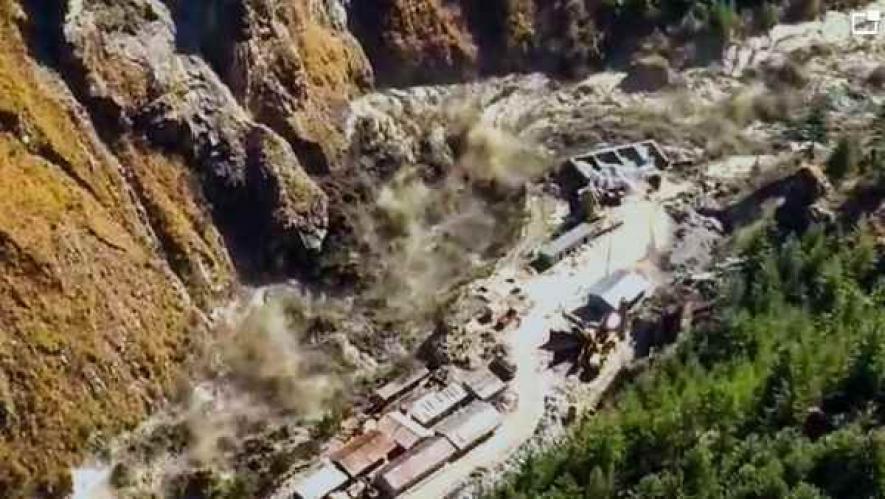Explainer: Glacial Burst of Uttarakhand That Caused Massive Flood

Image Courtesy: Oneindia
On Sunday, February 7, Dhauli Ganga, Rishi Ganga and Alaknanda rivers —all intricately linked tributaries of the Ganga-- were suddenly inundated and this created widespread panic and large scale devastations in Uttarakhand, especially in the Chamoli district.
The sudden massive flood caused extensive damages to two power projects—the Tapovan Vishnugad hydel project and the Rishi Ganga hydel project--with hundreds of workers trapped in tunnels as water rushed in no time. According to reports, 150 people are still missing with more than 19 reported dead. The rescue operations are underway.
What happened in Chamoli has been identified as a ‘glacial burst’ that took place in the Nanda Devi glacier, high in the Himalayas. The resulting flood deluged the tributaries of the Ganga. More specifically, the event is called GLOF (Glacial Lake Outburst Flood).
WHAT IS A GLACIAL LAKE OUTBURST FLOOD?
A GLOF is the sudden release of water from a lake that has formed in a glacier. The glacial lake is fed by the glacier melt and can form anywhere at the side, in front, within, beneath or on the surface of the glacier.
When such a glacial lake breaches, it is known as a GLOF. The event can cause catastrophic flooding downstream the lake-breaching site.
There can be several reasons that can cause a GLOF, such as erosion, building up of tremendous water pressure, avalanche of heavy snow or a rock, volcanic eruptions under the ice, collapse of adjacent glacier into the lake, which causes a massive displacement of water.
GLOFs are important from both geographical and socio-economic perspectives. Some of the largest floods in the history of Earth have been caused by GLOFs. They have created massive landscape changes and had even altered regional climatic conditions by the sudden release of huge quantities of freshwater into the oceans. GLOFs can pose huge risk in downstream communities and infrastructure.
WHAT CAUSED THE UTTARAKHAND GLOF?
The exact cause behind the Uttarakhand GLOF has not been ascertained yet. Farooq Azam, assistant professor of glaciology and hydrology at IIT Indore, said there was no glacial lakes in the region. This hints towards the existence of water pockets inside the glacier burst when it melted, which led to the gushing of water and tonnes of debris down the ravine. Azam also said that such an event is unusual.
Azam pointed towards the warming of the region—earlier the temperature of the ice ranged between -6 to -20 degree Celsius, but it is now -2 degrees, which makes the glacier susceptible to melting.
Again, some scientists believe that climate change is related to the event. This year, there were reduced snowfall in the higher elevations, according to a scientist who remained anonymous while speaking to Down to Earth.
All the glaciers, nearly 200, in Uttarakhand, Himachal Pradesh and Jammu and Kashmir could not be monitored during the winter due to weather conditions. It is only through March to September that weather favours for the glacier monitoring. Hence nothing very sure could have been told about the GLOF.
According to Maharaj K Pandit, Professor in Delhi University’s Centre for Interdisciplinary Studies of Mountain & Hill Environment,“The Himalayas are warming faster than other mountain ranges and the increased use of reinforced concrete in building construction, replacing the traditional wood and stone masonry there, is likely to create a heat-island effect and thus add to regional warming.” He also pointed towards the attitude of governments saying, “The government only does things after a disaster has struck, but is never proactive. We have been saying for a long time to set up an early warning system in the Himalayas, like the one set up in coastal areas after the 2004 tsunami, but it is still not there.”
Pandit further added, “Some 8,800 glacial lakes in the Himalayas are spread across countries and more than 200 of these have been classified as dangerous. Recent scientific evidence suggests that floods originating in the Himalayas are caused largely by landslides that temporarily block mountain rivers.”
The Hindu Kush Himalayan Monitoring and Assessment Programme (HIMAP) report facilitated by the ICIMOD (International Centre for Integrated Mountain Development) shows that the temperature in the Hind Kush Himalayan region and the global warming will have more impact in the Himalayan region.
Having said all these, the increased human interventions in the eco-sensitive Himalayan zones cannot be left ignored if a real assessment of the situation is expected. With the developmental projects coming in the Himalayan regions, the use of reinforced concrete cement structures replacing the traditional wood and stone masonry is accelerating a heat island impact in the mountain region, say experts. The construction of many dams, highways and railways as proposed from Rishikesh to Karnprayag etc.—all will be contributing to ecological dis-balance in the eco-sensitive region.
“Heavy construction work in the fragile eco-sensitive zones should be avoided," Avinash Chanchal, senior climate and energy campaigner, Greenpeace India, said. He further added that there is a need to rethink the current developmental model in the Himalayan region, which is likely to pose challenges to the environment and the local communities.
Get the latest reports & analysis with people's perspective on Protests, movements & deep analytical videos, discussions of the current affairs in your Telegram app. Subscribe to NewsClick's Telegram channel & get Real-Time updates on stories, as they get published on our website.























